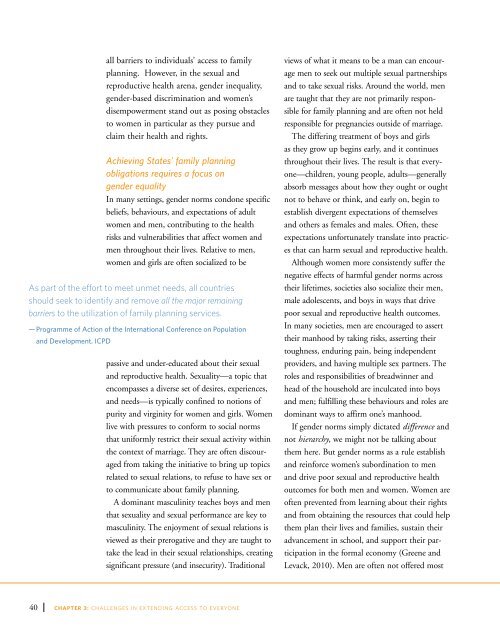State of World Population 2012 - Country Page List - UNFPA
State of World Population 2012 - Country Page List - UNFPA
State of World Population 2012 - Country Page List - UNFPA
You also want an ePaper? Increase the reach of your titles
YUMPU automatically turns print PDFs into web optimized ePapers that Google loves.
all barriers to individuals’ access to family<br />
planning. However, in the sexual and<br />
reproductive health arena, gender inequality,<br />
gender-based discrimination and women’s<br />
disempowerment stand out as posing obstacles<br />
to women in particular as they pursue and<br />
claim their health and rights.<br />
Achieving <strong>State</strong>s’ family planning<br />
obligations requires a focus on<br />
gender equality<br />
In many settings, gender norms condone specific<br />
beliefs, behaviours, and expectations <strong>of</strong> adult<br />
women and men, contributing to the health<br />
risks and vulnerabilities that affect women and<br />
men throughout their lives. Relative to men,<br />
women and girls are <strong>of</strong>ten socialized to be<br />
As part <strong>of</strong> the effort to meet unmet needs, all countries<br />
should seek to identify and remove all the major remaining<br />
barriers to the utilization <strong>of</strong> family planning services.<br />
— Programme <strong>of</strong> Action <strong>of</strong> the International Conference on <strong>Population</strong><br />
and Development, ICPD<br />
passive and under-educated about their sexual<br />
and reproductive health. Sexuality—a topic that<br />
encompasses a diverse set <strong>of</strong> desires, experiences,<br />
and needs—is typically confined to notions <strong>of</strong><br />
purity and virginity for women and girls. Women<br />
live with pressures to conform to social norms<br />
that uniformly restrict their sexual activity within<br />
the context <strong>of</strong> marriage. They are <strong>of</strong>ten discouraged<br />
from taking the initiative to bring up topics<br />
related to sexual relations, to refuse to have sex or<br />
to communicate about family planning.<br />
A dominant masculinity teaches boys and men<br />
that sexuality and sexual performance are key to<br />
masculinity. The enjoyment <strong>of</strong> sexual relations is<br />
viewed as their prerogative and they are taught to<br />
take the lead in their sexual relationships, creating<br />
significant pressure (and insecurity). Traditional<br />
views <strong>of</strong> what it means to be a man can encourage<br />
men to seek out multiple sexual partnerships<br />
and to take sexual risks. Around the world, men<br />
are taught that they are not primarily responsible<br />
for family planning and are <strong>of</strong>ten not held<br />
responsible for pregnancies outside <strong>of</strong> marriage.<br />
The differing treatment <strong>of</strong> boys and girls<br />
as they grow up begins early, and it continues<br />
throughout their lives. The result is that everyone—children,<br />
young people, adults—generally<br />
absorb messages about how they ought or ought<br />
not to behave or think, and early on, begin to<br />
establish divergent expectations <strong>of</strong> themselves<br />
and others as females and males. Often, these<br />
expectations unfortunately translate into practices<br />
that can harm sexual and reproductive health.<br />
Although women more consistently suffer the<br />
negative effects <strong>of</strong> harmful gender norms across<br />
their lifetimes, societies also socialize their men,<br />
male adolescents, and boys in ways that drive<br />
poor sexual and reproductive health outcomes.<br />
In many societies, men are encouraged to assert<br />
their manhood by taking risks, asserting their<br />
toughness, enduring pain, being independent<br />
providers, and having multiple sex partners. The<br />
roles and responsibilities <strong>of</strong> breadwinner and<br />
head <strong>of</strong> the household are inculcated into boys<br />
and men; fulfilling these behaviours and roles are<br />
dominant ways to affirm one’s manhood.<br />
If gender norms simply dictated difference and<br />
not hierarchy, we might not be talking about<br />
them here. But gender norms as a rule establish<br />
and reinforce women’s subordination to men<br />
and drive poor sexual and reproductive health<br />
outcomes for both men and women. Women are<br />
<strong>of</strong>ten prevented from learning about their rights<br />
and from obtaining the resources that could help<br />
them plan their lives and families, sustain their<br />
advancement in school, and support their participation<br />
in the formal economy (Greene and<br />
Levack, 2010). Men are <strong>of</strong>ten not <strong>of</strong>fered most<br />
40 CHAPTER 3: CHALLENGES IN EXTENDING ACCESS TO EVERYONE
















